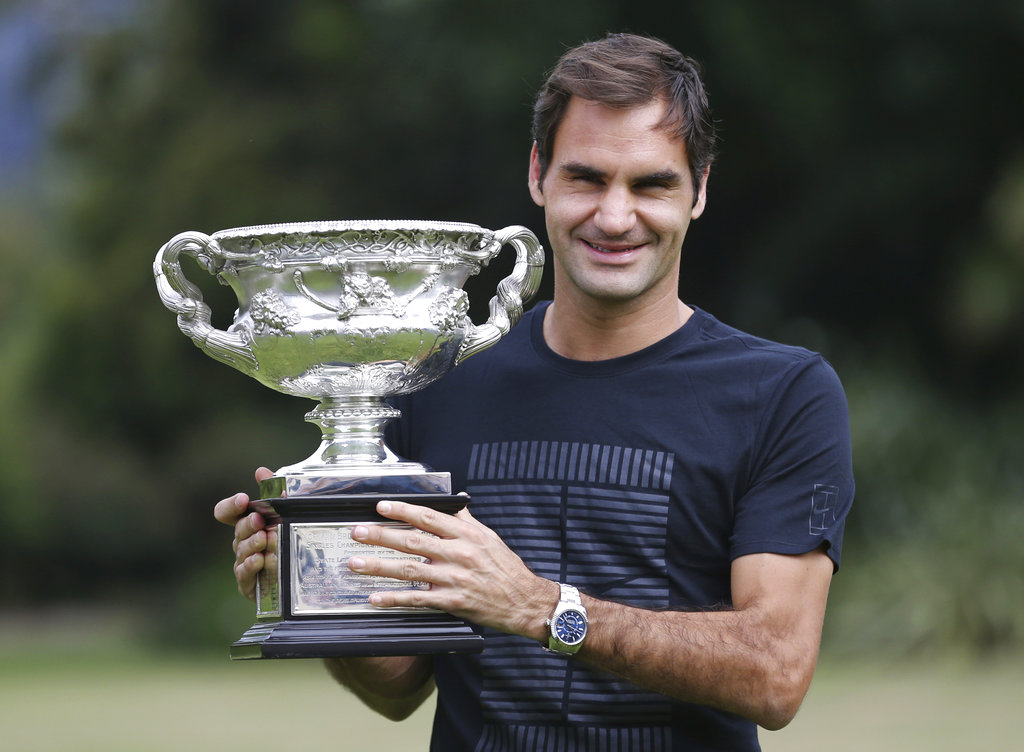
Switzerland’s Roger Federer poses with the Norman Brookes Challenge Cup after winning the men’s singles final at the Australian Open against Croatia’s Marin Cilic in Melbourne, Australia Monday, Jan. 29, 2018. (AP Photo/Dita Alangkara)
Used to be that Roger Federer simply could not win a match, let alone a championship, at major tournaments.
That might be hard to imagine now that Federer owns 20 Grand Slam trophies. But you can look it up: He lost in the first round on three of his first four trips to Wimbledon, and three of his first five appearances at the French Open.
So let’s recall what Federer said at the All England Club on the day he collected his very first Grand Slam title, all the way back in July 2003.
“I hope,” Federer said, “it’s not going to be my last.”
Seems silly nowadays, doesn’t it?
Because there he was, nearly 15 full years later, tears dotting his cheeks as he spoke to an adoring Australian Open crowd after beating 2014 U.S. Open champion Marin Cilic 6-2, 6-7 (5), 6-3, 3-6, 6-1 in Sunday’s final in Melbourne. Holding his most recent prize, Federer declared, “The fairy tale continues.”
It’s hard to decide what is most remarkable about Federer’s career.
Cilic’s take?
“The passion to compete, season after season, especially at this high level,” said the man who has lost two of the last three Grand Slam finals to the Swiss maestro. “Also, being able to challenge himself, first physically and then mentally, as well, to be at the top almost every single week.”
The sheer volume of it all does stand out. Federer has won exactly 10 percent of the 200 major tournaments contested in the professional era. Before Federer started collecting his 20, the most any man managed to accumulate was the 14 for Pete Sampras; he now stands No. 3, behind Federer and Rafael Nadal with 16.
There’s also that constant work to evolve and improve, most notably during his recent renaissance by adding versatility to his backhand side with a flatter, more powerful shot than his long-preferred slice.
And there’s the longevity, which is particularly impressive in light of the recent injury woes for the younger members of tennis’ elite: Nadal, Novak Djokovic, Andy Murray and Stan Wawrinka.
At 36½, Federer is now the second-oldest man to win a Grand Slam title in the Open era — Ken Roswell won Australia in 1972 at 37. And after going more than four years without a trophy, he’s added three in the span of four appearances at majors (he skipped last year’s French Open and sounds like someone contemplating doing so again in a few months’ time).
“I don’t think age is an issue, per se. It’s just a number,” he said Sunday. “But I need to be very careful in my planning, really decide beforehand what are my goals, what are my priorities. I think that’s what’s going to dictate how successful I will be.”
Federer was asked how long he thinks he can continue playing at this level.
“No idea. Honest, I don’t know. I have no idea. I’ve won three Slams now in 12 months. I can’t believe it myself,” he said. “I just got to keep a good schedule, stay hungry, then maybe good things can happen.”
Take a look at the way Federer earned his sixth Australian Open championship, tying the men’s record for most in history, to go along with his unprecedented eight Wimbledons, five U.S. Opens (tied for the most in the professional era) and one French Open.
After letting a lead slip away and getting outplayed by Cilic the fourth set, Federer faced some danger in the opening game of the decider in the form of two break points.
“Momentum,” Cilic would say later, “was on my side.”
Right when nerves would figure to be most frayed, Federer was steadier. On the initial break chance there, Cilic got a look at a 104 mph second serve and dumped a forehand return into the net. On the next, Cilic pushed a forehand return wide off a 119 mph first serve up the “T,” and Federer yelled out in Swiss German. Two points later, Federer conjured up a cross-court backhand winner that clipped the outside of a line to cap a 15-stroke exchange and grab that game.
In the next, Cilic double-faulted twice and Federer took advantage, breaking en route to a 3-0 lead. And that was pretty much that.
Federer was on his way, just like so many times before.
“It’s always very, very challenging to play him,” Cilic observed.
Wasn’t always that way at the very beginning, actually. Yet it very much is, all these years later.

